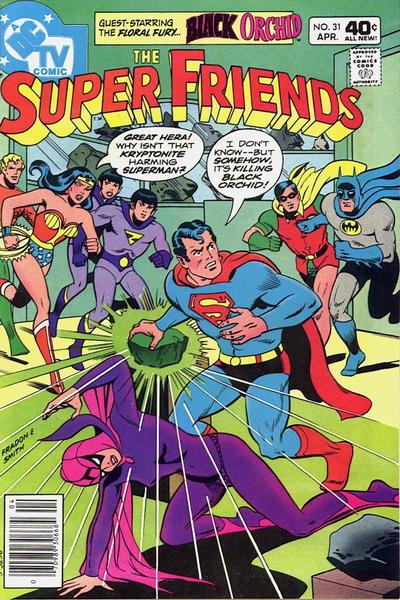The Wonder Twins did get some development in the comic beyond the exceedingly limited treatment they had on the cartoon. The range of transformations seemed more vigorous and imaginative, and the duo were even given secret identities and a hint of a homelife.
Bridwell did a good job of working in recognizable figures from the cartoon as well as the DCU into the stories. Villains such as the Scarecrow and Gorilla Grodd were part of the cartoon but also were up and running villains in the pages of the comics. A standout issue co-starring Black Orchid reallly pops off the stands, as she's a character rarely given any attention beyond her short-lived early 70's series. She seems an odd fit for the Super Friends given the dark tone of her previous stories.
But mostly the comic book could be counted on for a light-hearted yarn or two which had heroes functioning as heroes and were not overcome by the complexities of a life fighting crime. Seeing heroes like Wonder Woman, Superman and especially Batman and Robin smiling was a welcome change considering the sober events often occuring in their own books.
DC won first place in my admiration of comic companies when in the late 70's they actually seemed to be doing something about the rising prices of comic books. Whereas at Marvel you'd get a bleat or two bemoaning the inevitability of prices increases and little else, DC was trying out different formats at different price points. When they jumped to fifty cents, they added pages and gave readers more features with a raft of interesting back-ups in all their comics. In Super Friends we got The Seraph and Jack O' Lantern, two of the international heroes created by Bridwell. Romeo Tanghal and Bob Oksner drew these interesting features.
Plastic Man would up as well, and that made sense since Plas would soon be given his own cartoon show from Ruby-Spears. Marty Pasko and Joe Staton created a hectic fun version of Plas, and he was a welcome addition to the comic. Green Fury was an oddity, as the lovely Brazilian heroine became a common sight in the pages of the regular Super Friends stories, almost as if she was being considered for inclusion into the team.
While Bridwell's international heroes showed up from time to time in the comic, the worldly ethnic heroes from the cartoon never appeared. We never see Black Vulcan, El Dorado, Apache Chief, nor Samurai in the pages of The Super Friends. But we do get the likes of Godiva, Bushmaster, Olympian, Little Mermaid and Wild Huntsman.
The series seems to have ended somewhat abruptly in 1981. Bridwell had suggested that his villainous future villains Futurio and Futurio XX had another incarnation, but we never see it. Instead, the series ends on a yarn featuring and explaining the origin of Green Fury. It must be noted that artist Romeo Tanghal had taken over the penciling chores on the main feature with issue forty-two and to my eye the series lost a step. Tanghal was a fine artist but his take on the team was somewhat pedestrian compared to Fradon's dynamic pages.
The Super Friends ended in part to make way for new interpretations of DC's animated stars. The familiar Super Friends would go away only to be replaced eventually by a very different approach to which cleaved even more tightly to current DC continuity. And the whimsical world created by Bridwell would be replaced with a vigorous approach developed by the great Jack Kirby himself. More on that next time.
Rip Off

























This comment has been removed by a blog administrator.
ReplyDelete